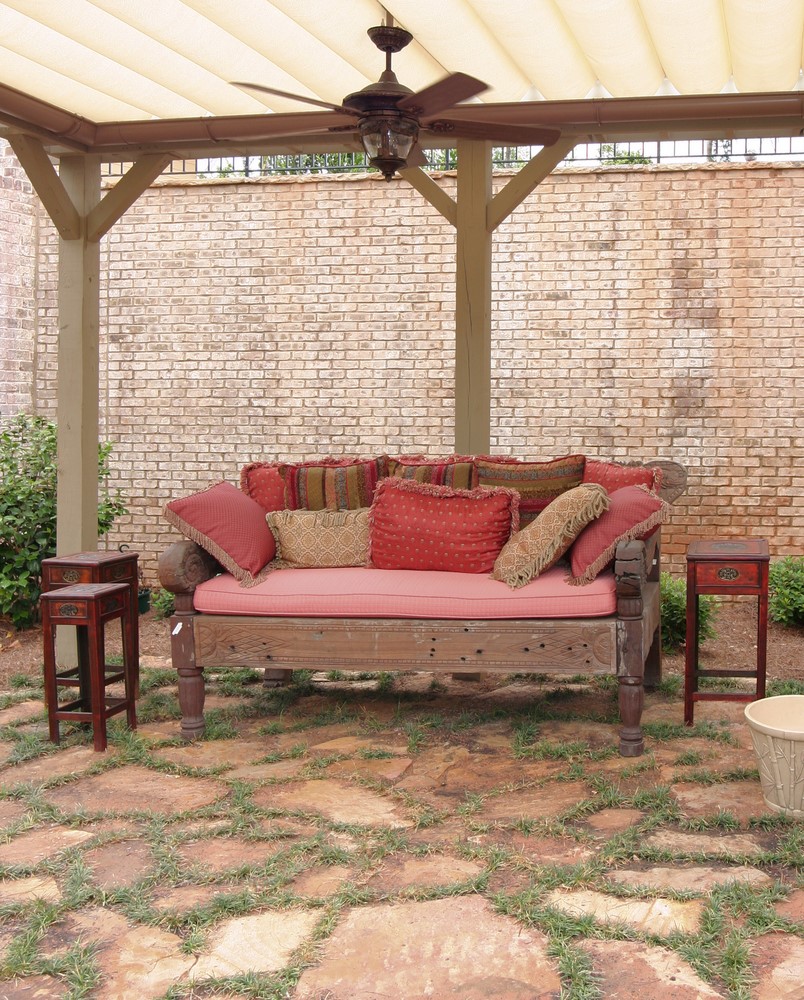You want to make your indoor-outdoor space as comfortable as possible, so you can enjoy every second you spend in the fresh air. You have decorated the space perfectly, with sumptuous furniture, thriving plants and beautiful details that match the style of your home. There’s just one problem: It gets hot in the summertime.
Even if your deck or patio is covered and shaded, the summer sunshine can cause uncomfortable heat. A ceiling fan can provide gentle airflow that helps to keep you and your guests cool — but before you buy a ceiling fan to hang over your outdoor space, you need to consider the following challenges.
Structure
A ceiling fan is much larger and heavier than a light, and the fact that a fan moves means that it is an appliance that requires a significant amount of support from the structure it is attached to. It should go without saying that you cannot attach a ceiling fan to an umbrella or cloth awning; you need a permanent and steadfast structure covering your outdoor area if you want to hang a ceiling fan overhead.
Ceiling fans vary in size and weight, so the strength of the structure required will vary depending on the make and model you select. There are special ceiling fan electrical junction boxes that are built to attach firmly to the supports of the ceiling, and if you are installing the fan yourself, it is imperative that you research what type of box you need to hold up your fan’s weight. Then, you might need to inspect your patio cover for signs of damage that could compromise its integrity before you can be certain that a ceiling fan will be safe.
Moisture
Moisture is incredibly bad for electronics — especially electronics that are hard-wired into your home’s electrical system. To some extent, an outdoor fan will always have its wiring subject to the outdoor elements, which includes plenty of moisture through rain and snow, humidity and even human recreation. If improperly installed, the wiring within fans will short when exposed to this moisture, causing damage to the fan and making your outdoor area dangerous for you and your guests.
It is essential that you invest in outdoor ceiling fans that are appropriately rated for the level of moisture they are likely to encounter. For example, if you are hanging a fan in a pergola, you likely need a wet-rated ceiling fan, which can withstand becoming drenched due to rain and snow. If your ceiling fan is more protected, far underneath a more robust cover, it might only need to be damp-rated, meaning it can endure the corrosive effects of humidity but not direct contact with water.

Dirt
Aside from enclosing your outdoor space and transforming it into an indoor space, there is no way to save any item in your yard from becoming dirty. Even if you are diligent about cleaning your ceiling fan regularly to prevent it from becoming caked in dirt, the wind will carry the grit and grime of the outdoor air into your fan essentially every moment it hangs outside. It does not take much time for dirt to take a toll on the delicate workings of the fan’s motor and other integral components of the fan, causing damage that could end the fan’s life prematurely.
Again, the best and only solution to this problem is to procure a high-quality fan that is rated for outdoor use. Outdoor fans have more robust workings, with protective components that prevent dirt from infiltrating the most sensitive parts of the machine. Additionally, you should commit to cleaning your fan every month or so. If you have a wet-rated fan, you can gently spray your fan with a hose to wash off dust and dirt. If your fan is merely damp-rated, you will need to manually wipe down the blades and motor case to keep it functioning optimally. A ceiling fan is an excellent addition to an outside space, but considering that a ceiling fan is a complex appliance, you need to be confident that you are installing the proper fan in the proper place. As long as you have looked into the structure above your outdoor space and reviewed the moisture and dirt levels of your region, you should be able to make informed decisions about your outdoor fans.







